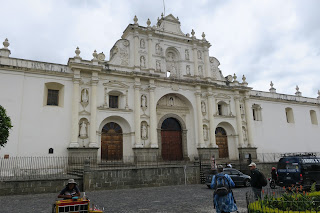The Cathedral of St Joseph, located in the city of Antigua Guatemala, is
located in a section of the old Primate Cathedral of Santiago de los
Caballeros, which was destroyed by the 1773 Guatemala earthquakes.
The first building was begun in 1545 with rubble brought from the destroyed
settlement in the valley of Almolonga. Its construction was hampered by
frequent earthquakes. A second sanctuary would be inaugurated in 1680.
Cathedral status was obtained in 1743. The first cathedral housed the remains
of the conquistador Pedro de Alvarado who had been transferred there at the
request of his daughter in 1568, but disappeared following one of the multiple
earthquakes that damaged the city over the years.
After the earthquakes of 1773, the Cathedral was moved to Nueva Guatemala de
la Asunción (Guatemala City) on November 22, 1779 and the Parish church of El
Sagrario, which also worked on the premises, in May 1780. The altarpieces,
furniture and instruments of the old cathedral remained on the premises, but
in 1783 they were removed and stored in the building of the University of San
Carlos, located in front of the cathedral, and in the sacristy of the Parish
El Sagrario. The gigantic walls of the building continued in foot; the
interior was used as a cemetery.
|
Main facade of the Cathedral of St Joseph.
The cathedral of Santiago had three constructions; the last of them was
consecrated in November 1680 and was the work of master Joseph de
Porres.
-
In 1718, after the 1717 Guatemala earthquake (San Miguel earthquakes),
Diego de Porres repaired the vaults, the arches, the dome, the second
body and the façade.
|
|
Entrance through the side door.
Through a side door you enter the ruined main nave.
|
|
Main altar.
The main altar stood under a dome, supported by sixteen columns lined
with carey and decorated with elaborately worked bronze medallions. On
the cornice were placed the image of the Virgin Mary and the twelve
Apostles, made of ivory.
-
The altarpieces, furniture and instruments of the old cathedral
remained on the premises, but in 1783 they were removed and stored in
the building of the University of San Carlos, located in front of the
cathedral, and in the sacristy of the Parish El Sagrario.
-
The gigantic walls of the building continued in foot; the interior was
used as a cemetery.
|
|
Chapel of the Virgin of Help.
-
In the colonial era, it was documented in the books of History that
the Virgin of Help (Virgen del Socorro) was the image of the
Virgin Mary that the conqueror Pedro de Alvarado had the most devotion
in the colonial era.
-
It is documented that this image came with Pedro de Alvarado when he
came to conquer Guatemala. Previously it was in the port of Veracruz.
And already in the Guatemalan land the first mass was carried out in
this newly conquered land. For such reason the Virgin of Help was the
image with the most devotion in Antigua Guatemala. To this devotion is
attributed the fact that they named her Patroness of the rains for
good harvests.
-
In the streets of Antigua Guatemala, at that time, a Procession of
Blood (Procesión de Sangre) (penitence or rogative) was carried
out, asking the Virgin of Help for the rains so that the harvests were
very abundant. After the Virgin left the Church, which was designated
as a Cathedral, and visited one of the closed convents of the old
kingdom, and after the nuns rejoiced at such a distinguished visit and
honored and worshiped her with the song of the Salve, precisely at the
days after it rained.
|
|
Main altar and main nave.
The main altar is in the foreground, the site with the remains of Pedro
de Alvarado is on the left, and the main nave is in the background.
-
The cathedral housed the remains of the conqueror Pedro de Alvarado
that had been transferred at the request of his daughter in 1568.
-
They were raised during the 1940s and taken to the Peace Court until
1976, when an earthquake forced them to be stored in the Municipality
of Antigua Guatemala, where they remained until December 2007, when
they returned to the same niche he had occupied in the Cathedral of
Antigua Guatemala.
|
See also
Source
Location
Antigua Guatemala
Iglesia y Convento de las Capuchinas
Iglesia de La Merced
Guatemalan Jade
El Carmen
Santa Teresa de Jesús Convent
Centro Cultural la Azotea
Las Antorchas Restaurant
El Refectorio Restaurant
Hotel Museo Casa Santo Domingo









